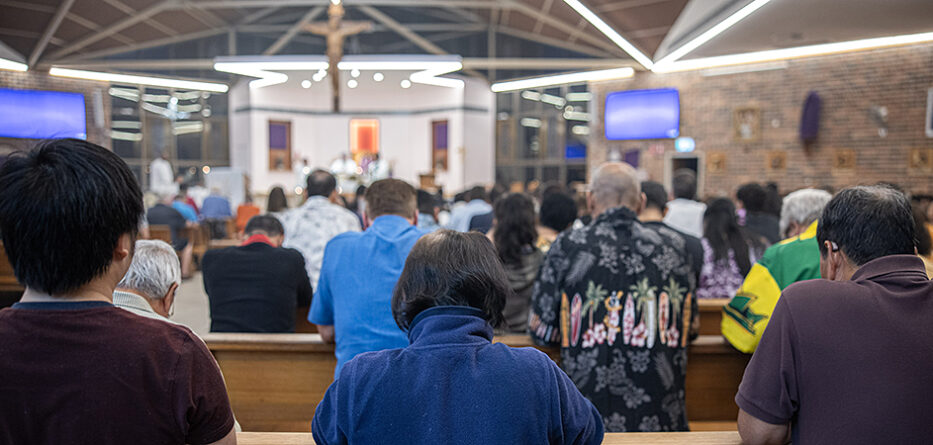POLARISATIONS AND PUSHBACK:
Some ask about polarisations occurring within the Church, and they expect honest answers. Others give me their own frank and honest opinions. Their concerns deserve respectful dialogue. Yet others have partially removed themselves from in-house discussion by opting for a “spirituality” more or less independent of the Church. Confusions that come to us from the wider secular culture are another matter again.
Some of the polarisations within the Church can be described as “pushback.” It is important to understand the reasons for push-back – from whichever direction it comes. It needs to be made fruitful. Otherwise, it just degenerates into culture wars. These have already reached fever pitch in some parts of the world. We don’t need that.
But first the good news: the common ground between polarised positions within the Church is that people’s faith really matters to them. Perhaps we should be more concerned about those who seem not to notice. Above all, however, small family arguments should not be given more time than we give to reaching out to people in need and working to transform society.
NOT NEW
Some of today’s pushbacks are residue from previous pendulum swings. In its day, feudal society had found an echo in the Church, some of the bishops being princes and lords. That kind of society is what the French Revolution pushed back against, by calling for liberty, equality, and fraternity – and by persecution. Persecution rebounded in the form of many new religious orders, expanded missionary work, and a revival movement, which was known as Ultramontanism because it was centred on Rome (“over the mountains” from northern Europe.)
Features of this revival included parish missions and multiple devotions, processions, apparitions, miracles, pilgrimages, scapulas, medals, and novenas – which have their place, though not as bargain for salvation. It is the era of neo-Gothic and baroque architecture, and exuberant adornment of churches. Clergy became a group apart even more, and later, with dress to match. The First Vatican Council (1869-70) was the first to which no lay people were invited.
The era featured a theology that became increasingly unable to address modern questions, culminating in the anti-Modernism of Popes Pius IX and X. Intellectual enquiry was not encouraged, and complete subordination to Church authority, especially the Pope’s, was the order of the day. With some variations, this gave us our experience of Catholicism up until the 1960’s.
The much-needed corrective came with ressourcement: better methods of studying the ancient scriptures, and the liturgies, theologies, and practices of Christianity’s earlier centuries, gradually emerged, and fed into the renewal mandated by the Second Vatican Council.
Some of today’s pushback is a hankering for features of Ultramontanism; and some of those features are mistaken for “tradition.”
DIFFERENT EXPERIENCES
Pushback can also arise from different generations’ experience. Some of us grew up within a Church that was controlling, paternalistic, clericalist and conformist. The post-Vatican II Church included pushback against that way of being Church. There were good reasons for this – based on what it means to be a person and what it means to fully respect the primacy of conscience:
“The dignity of the human person is a concern of which people of our time are becoming increasingly more aware. In growing numbers people demand that they should enjoy the use of their own responsible judgment and freedom and decide on their actions on grounds of duty and conscience, without external pressure or coercion.” (On Religious Liberty –Dignitatis Humanae, n.1.)
A true appreciation of personhood and of conscience fosters personal responsibility in others. It relies more on catechesis and moral formation than on regulation and penalties. It is more akin to author-ising or enabling others to grow as persons. It requires a formation aimed at helping them to understand the issues and to choose well. It moves away from social patterns and leadership styles that were more typical of feudal societies, and that prolonged over-dependence and personal immaturity. This accounts for different expectations of how Church leadership should be exercised. There has been pushback from some who fear that respect for the autonomy of persons and the primacy of conscience involves a failure to uphold church teachings.
Those who grew up since the 1960s have not experienced a highly authoritarian and conformist way of being Church. But they have experienced the emptiness of secular ideology and the triteness of consumerism, and they are pushing back against that. They rightly look to the Church for a strong sense of the transcendent and clear markers against false ideologies and are concerned when it seems to them that the liturgy renewal involves a diminished sense of mystery and of the transcendent.
Conversely, of course, some of their efforts to emphasise transcendence can seem to others like an over-emphasis on secondary matters and externals. After all, even the Church’s teachings do not all have the same level of importance:
“… the biggest problem is when the message we preach seems identified with secondary aspects which important as they are, do not in and of themselves convey the heart of Christ’s message…(Pope Francis, The Joy of the Gospel, n.34)
FROM CEREMONY TO RITUAL
That applies also to Church practices. In his scholarly article, ‘One Hundred Years of the Discipline of the Liturgy’ (Australasian Catholic Record, Oct 2023), Gerard Moore reminds us of the difference between “ceremony” and “ritual”. We watch a ceremony and we participate in a ritual (acknowledging some overlap). Before the Second Vatican Council, it was assumed that the congregation “attended” Mass, which the priest “celebrated”. It was the priest’s responsibility to ensure the ceremony was correctly performed, and there were manuals that spelled that out in much detail. It easily became a preoccupation with rubrics, vestments, birettas, mitres, candles etc.
But the Council reminded us that the Mass is not a ceremony which the congregation attends, it is a ritual in which they participate. Although the priest has a special ministry, it is the whole congregation that celebrates Eucharist.
There are also polarised expectations resulting from how we think of “mystery” and “reverence.” The confusion derives from pre-Council times when we did not have a good understanding of the difference between “devotions” and “liturgy” – they were all “what we did in church”. Our understanding of “reverence” derived mainly from our demeanour before the Blessed Sacrament. That kind of reverence, proper to Eucharistic devotions, can inhibit the sense of mystery and of reverence that properly belong to liturgy. (That is why official sources prefer the reserved Sacrament to have its own special place, apart from the sanctuary. It is not part of the liturgy.)
In liturgy, properly understood, the “mystery” is indeed Christ’s real presence, and “reverence” is the way we respond to what He is doing for us, which is different in each of the sacraments and at different moments in the celebration of Eucharist. An example might help: For Polynesian Catholics, the Gospel procession involves song, dance, and expressions of joy at Christ’s coming among us in his word, and the congregation rises to its feet out of respect. When I explained this to a group of seminarians, one commented that this could be “a distraction.” That good man was still thinking of the kind of reverence we express in the presence of the reserved Sacrament and in private prayer. The Gospel procession invites us to come out of our private time to join a worshipping community – to participate in a ritual.
Bishop Peter Cullinane is Bishop Emeritus of The Diocese of Palmerston North, New Zealand. This is the first part of a two-part article. The second part will be published tomorrow.
This article was originally published in the 24 March – 6 April edition of NZ Catholic, a news publication of the Diocese of Auckland. Reproduced with permission.








